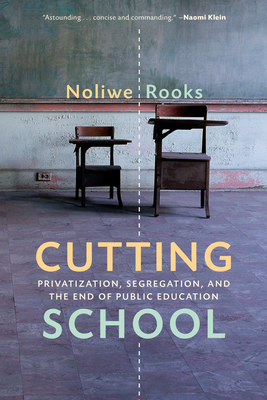Cutting School: Privatization, Segregation, and the End of Public Education
Noliwe Rooks

My partner had read this book previously, and I decided to read it after hearing Rooks on a podcast (Radical Bureaucrat). Rooks has written a book that is smart, critical, and accessible. I think it has supplanted Dale Russakoff’s “The Prize” as the first book I would recommend to any general-interest reader wanting to learn more about the recent history of education reform. Both books are skeptical of the mainstream of education reform, but Rooks’s is more comprehensive and does more to connect key aspects of today’s movement to a history stretching back to the earliest years of public education in the United States.
A couple of main takeaways from the book: First, the current wave of “no excuses” test-prep-focused charter schools are part of a long tradition of applying different educational approaches to poor students and students of color, stretching back to the movement for vocational education for Black students during the Progressive era. Rooks observes that policymakers have long used disadvantaged student populations as opportunities to experiment. She argues that this continues at least in part because the continued existence of segregated and underserved student populations is a source of potential profits for corporations, citing for example the rise of “virtual charters.” Second, while empirical evidence on the efficacy of different educational strategies is generally mixed, integration is one approach that has consistently been found to be effective, yet was more or less abandoned in the 1970s and has never been returned to the policy agenda–again, perhaps in part because of the profit incentives I mentioned above. Third, the current ed-reform movement tends to be uninterested in listening to the voices of the students, educators, and communities that it ostensibly is intended to serve–demonstrated for example in its focus on districts that are under state or mayoral control as opposed to those under more traditional democratic governance structures. Rooks pushes back on this trend in part by incorporating some of these voices into her own book.
My one critique of the book is that Rooks often uses language in something like the following form (my paraphrase/example): “While some in the movement are certainly motivated by a sincere desire to help poor students, many are motivated by the significant profits to be made.” What I’m identifying here is the structure of “some good/others bad,” as contrasted to a characterization that recognizes that we are all motivated by a mix of motives, both conscious and unconscious. I think the “some/others” construction encourages people to sort themselves into categories, and of course we are all inclined to sort ourselves into the “good” category. I see the alternative characterization as preferable because it encourages all of us to think about the ways, both conscious and not, that we may be influenced by structural forces that don’t align with our values–and to think about what we can do to alter those structures.